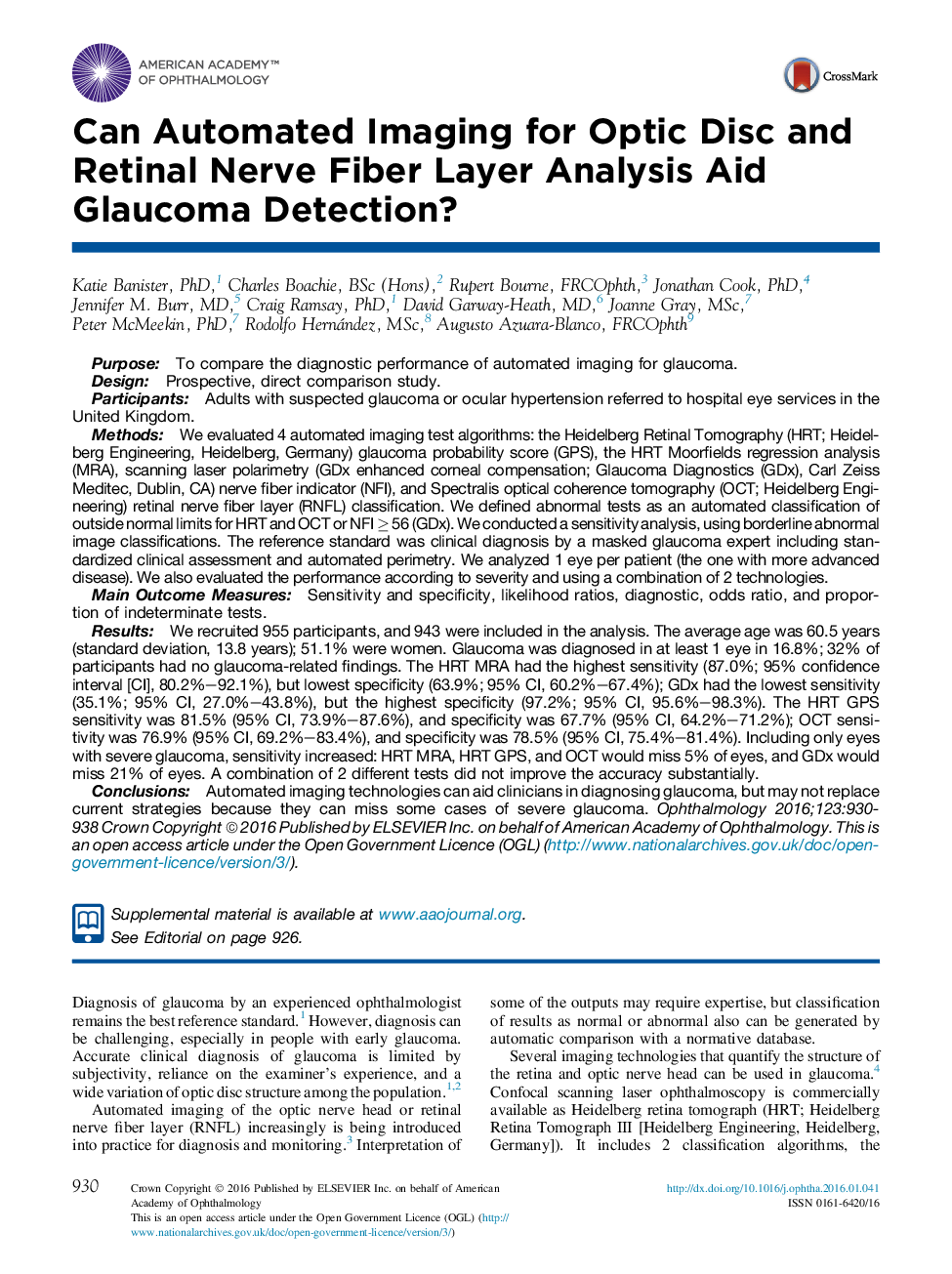| کد مقاله | کد نشریه | سال انتشار | مقاله انگلیسی | نسخه تمام متن |
|---|---|---|---|---|
| 6199816 | 1262404 | 2016 | 9 صفحه PDF | دانلود رایگان |
PurposeTo compare the diagnostic performance of automated imaging for glaucoma.DesignProspective, direct comparison study.ParticipantsAdults with suspected glaucoma or ocular hypertension referred to hospital eye services in the United Kingdom.MethodsWe evaluated 4 automated imaging test algorithms: the Heidelberg Retinal Tomography (HRT; Heidelberg Engineering, Heidelberg, Germany) glaucoma probability score (GPS), the HRT Moorfields regression analysis (MRA), scanning laser polarimetry (GDx enhanced corneal compensation; Glaucoma Diagnostics (GDx), Carl Zeiss Meditec, Dublin, CA) nerve fiber indicator (NFI), and Spectralis optical coherence tomography (OCT; Heidelberg Engineering) retinal nerve fiber layer (RNFL) classification. We defined abnormal tests as an automated classification of outside normal limits for HRT and OCT or NFI ⥠56 (GDx). We conducted a sensitivity analysis, using borderline abnormal image classifications. The reference standard was clinical diagnosis by a masked glaucoma expert including standardized clinical assessment and automated perimetry. We analyzed 1 eye per patient (the one with more advanced disease). We also evaluated the performance according to severity and using a combination of 2 technologies.Main Outcome MeasuresSensitivity and specificity, likelihood ratios, diagnostic, odds ratio, and proportion of indeterminate tests.ResultsWe recruited 955 participants, and 943 were included in the analysis. The average age was 60.5 years (standard deviation, 13.8 years); 51.1% were women. Glaucoma was diagnosed in at least 1 eye in 16.8%; 32% of participants had no glaucoma-related findings. The HRT MRA had the highest sensitivity (87.0%; 95% confidence interval [CI], 80.2%-92.1%), but lowest specificity (63.9%; 95% CI, 60.2%-67.4%); GDx had the lowest sensitivity (35.1%; 95% CI, 27.0%-43.8%), but the highest specificity (97.2%; 95% CI, 95.6%-98.3%). The HRT GPS sensitivity was 81.5% (95% CI, 73.9%-87.6%), and specificity was 67.7% (95% CI, 64.2%-71.2%); OCT sensitivity was 76.9% (95% CI, 69.2%-83.4%), and specificity was 78.5% (95% CI, 75.4%-81.4%). Including only eyes with severe glaucoma, sensitivity increased: HRT MRA, HRT GPS, and OCT would miss 5% of eyes, and GDx would miss 21% of eyes. A combination of 2 different tests did not improve the accuracy substantially.ConclusionsAutomated imaging technologies can aid clinicians in diagnosing glaucoma, but may not replace current strategies because they can miss some cases of severe glaucoma.
Journal: Ophthalmology - Volume 123, Issue 5, May 2016, Pages 930-938
